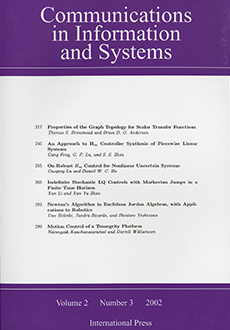Abstract
The objective of this article is to present geometric and numerical techniques developed to study the orbit transfer between Keplerian elliptic orbits in the two-body problem or between quasi-Keplerian orbits in the Earth-Moon transfer when low propulsion is used. We concentrate our study on the energy minimization problem. From Pontryagin’s maximum principle, the optimal solution can be found solving the shooting equation for smooth Hamiltonian dynamics. A first step in the analysis is to find in the Kepler case an analytical solution for the averaged Hamiltonian, which corresponds to a Riemannian metric. This will allow to compute the solution for the original Kepler problem, using a numerical continuation method where the smoothness of the path is related to the conjugate point condition. Similarly, the solution of the Earth-Moon transfer is computed using geometric and numerical continuation techniques.
Citation
B. Bonnard. J.-B. Caillau. G. Picot. "Geometric and Numerical Techniques in Optimal Control of Two and Three-Body Problems." Commun. Inf. Syst. 10 (4) 239 - 278, 2010.
Information





